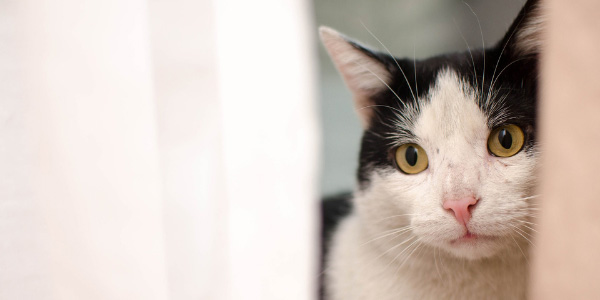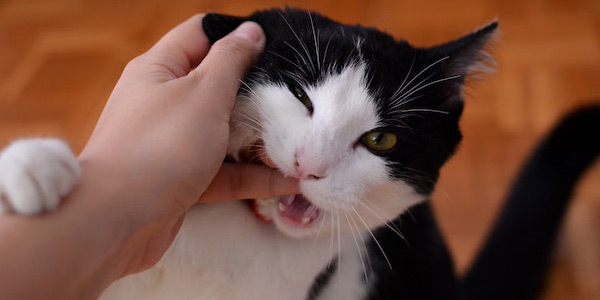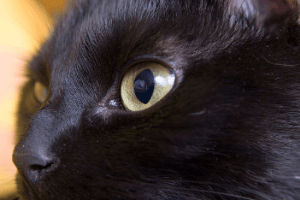 As a general rule, most cats are excellent at hiding their pain. Cats are masters at disguising pain. It's a survival instinct.
As a general rule, most cats are excellent at hiding their pain. Cats are masters at disguising pain. It's a survival instinct.
Fortunately, there are many signs you can look for that may indicate your cat is in pain.
Knowing what to look for is the key, so you can prevent your cat from suffering in silence.
Signs of Pain in Cats
Chances are you know your cat pretty well and better than most — even your veterinarian! Cat owners are often the first to recognize when something isn't right in their precious feline friend, which may include even the most subtle of signs.
Therefore, if you have a good idea of your cat’s “normal,” such as their normal attitude, energy level, gait, appetite, thirst, sleep patterns, and other physical and behavioral patterns, it’s much easier to recognize when they’re not acting quite right.
*Important note: When evaluating your cat for potential pain, there is a chance that you or someone helping you could get bitten or scratched, so remember to be careful.
Even if your cat would never normally bite or scratch, the mere fact that you’re checking them for pain gives them the idea that something's up!

Biting and Scratching
Cats in pain are more likely to bite and scratch. And they are not discriminatory — so even familiar people may be the target of their teeth, claws, or both! This is particularly true when a person touches or moves the painful area or if the cat anticipates you touching or moving the painful area.
Breathing Changes
A cat in pain may breathe faster or shallower when experiencing pain. They may also pant. You may even notice a change in the movement of the stomach and chest muscles since both are involved in breathing.
Checking your cat’s respiratory rate at home:
Count your cat's breaths for 15 seconds when they're asleep (at rest), then multiply it by 4 to get the number of breaths per minute. You can use the timer on your phone and place your hand on their chest to feel their breaths as you count. Or watch their chest rise and fall = 1 breath.
The normal rate for cats is between 12 and 60 breaths a minute. Make sure your cat is not sniffing, awake, or moving around when you're trying to count, as this will lead to inaccurate counts.
This video gives tips on how to check your cat's breathing rate at home, as well as other vital signs:
Heart Rate and Pulse Changes
These are interchangeable terms and essentially mean the same thing. The speed of your cat’s heart is the same speed of their pulse as it pumps blood from their heart to their vessels.
Pain and discomfort often result in increasing your cat’s heart or pulse rate. Additionally, the rate often noticeably speeds up when the painful area is touched or moved.
The normal heart rate in a cat at REST (asleep) is between 160–200 beats per minute. And similar to how you count your cats’ respiratory rate, you can count your cat's heart or pulse rate at home but placing your hand over their chest just behind their elbow and try to count the number of beats in 15 seconds and multiply it by 4.
As a cat’s heart rate is typically very fast, this can often be quite tricky to do. So relying on other things, such as their respiratory rate, demeanor, body position changes, etc., may be more helpful.
You can also take a pet first aid course or ask your veterinarian or one of the clinic's nurses to show you how to check your cat's vital signs.
Gum color
The normal gum color for a cat is light pink, which can vary slightly. If your cat will tolerate you lifting their lip gently (don’t get bitten!) You can gently inspect the gum color.
Gum color shouldn’t be white/grey/blue or purple — this may indicate a lack of oxygen to the tissues.
It also shouldn’t be bright red, as this could indicate increased blood pressure, pain, or inflammation.
Purring
Although purring typically indicates happiness in our cats, they may also purr to communicate when they are stressed, anxious, or trying to communicate other needs, such as if they are painful or uncomfortable.
So, if your cat is purring while showing any of the other signs listed here, the purring may be pain-related. In fact, purring may actually increase in a cat experiencing pain.
 Eye Changes
Eye Changes
The eyes can be very telling in cats with pain. This is true both for eye pain itself and for pain elsewhere in their body.
Often, pain elsewhere in the body will result in larger (dilated) pupils, while pain in the eye can result in either larger or smaller (constricted) pupils – depending on the underlying injury or disease process to the eye and whether one or both eyes are affected.
Squinting may indicate pain, either in the squinting eye or elsewhere in the body. Similarly, a “bloodshot” appearance can indicate pain in the affected eye.
Changes in Eating or Drinking
Depending on where your cat is experiencing the pain, you may find them eating and drinking less. This may be because they are painful and don’t want to get up to walk to their food bowls.
One fix for this is to move their bowls closer to them. If they still don’t want to eat or drink, the issue may be related to something else, such as something internal.
When they are eating, if the cause of their pain is their teeth or some other part of their mouth, they may drop food out of their mouth or drool while eating. Mouth or tooth pain may also be another reason for food avoidance.
Grooming Changes
You may notice an overall decreased amount of self-grooming in a cat experiencing pain or generalized illness. This is typically because they lack the energy to perform these regular functions, or it may hurt to do so. However, a cat that has a wound may excessively groom the area, which will only cause further trauma and damage.
Learn how to care for your cat's wound to help them heal properly.
Energy Level Changes
Most cats in pain will generally be less active. This often results in a cat who sleeps more but may also reduce the amount the cat runs or jumps.
Hiding
Many cats will hide when in pain — choosing to spend time under beds or couches or even in closets. Be sure to check frequently for hiding, as it’s often a very telling sign, especially if this is an uncommon activity for your feline.
Mobility Changes
Pain can often result in decreased movement. However, depending on what hurts, your cat might still move around the same amount, but it may just look a little different. You may notice a limp, or that they move more slowly up or down the stairs, or be less eager (or able) to jump the way they used to.
If you've noticed any of these changes in your cat's mobility, or you think your cat might be suffering from arthritis — and LOTS of cats are — you may wish to consider adding some joint mobility and fish oil supplements to their food.
These don't require a prescription, can help with inflammation in the joints, and may help improve your cat's pain and quality of life. However, it is always recommended to discuss these choices with your veterinarian first, as your cat may benefit from prescription pain medications in addition to supplements at this stage.
Changes in Bathroom Habits
Given the way cats position themselves in their litter box to poop and urinate, pain may cause them to struggle to be able to go! Therefore, you may notice less dirty litter to clean up. This can be a warning sign that something isn't right.
Additionally, because of this struggle to go to the bathroom, cats may sometimes become constipated. Cats with joint or bone pain may also have difficulty getting into their litter boxes, so they may start urinating and/or defecating outside of their boxes.
Questions? If you're concerned your cat is in pain and would like to speak with a veterinarian, Click here
Body Contour Changes
Swelling on your cat’s legs, body, or face could be an indication of a painful condition such as a cat bite, tooth root abscess, inflammation, cancer, insect bite, allergic reaction, or something else.
Additionally, if your cat has recently undergone surgery or a dental procedure, your vet will have provided you with discharge instructions and possibly medications.
It is always VERY important to follow these instructions to the T to ensure the best recovery for your cat!
They could be experiencing some form of discomfort depending on what the procedure was – they may be quieter, less inclined to want to cuddle or be pat, and may refuse food or water for a few hours after coming home from the hospital and may just wish to rest.
Cat Pain Questionnaire
Based on the research they've conducted, Dr. Duncan Lascelles, one of the foremost experts on pain in cats, and his team at North Carolina State University College of Veterinary Medicine have created a helpful questionnaire to help you and your veterinarian determine if your cat might be "suffering in silence" from arthritis pain.
You can download their questionnaire to print out and then complete it. Bring it to your veterinarian to help determine whether or not your cat has arthritis. Below is a short video Dr. Lascelles has produced, which takes you through some of the important aspects of cat pain.
Conditions That Are Often Painful for Cats
Five Things About Cat Pain:
- Cats often hide their pain, so look for subtle signs.
- Cats in pain are more likely to bite, so be careful!
- Behavior, breathing, heart rate, and even appearance can all change when your cat is in pain.
- Always call your veterinarian if you suspect your cat is in pain.
- Never give your cat medication unless instructed to do so by your veterinarian.
While it’s quite obvious and intuitive that a broken bone, gaping wound, or surgical procedure will likely be painful to your cat, those aren’t the only reasons for pain.
There are lots of other common conditions that cause pain that often goes unrecognized by cat owners and therefore untreated by their veterinarians as we can’t ask our patients how they are feeling today!
If your cat has been diagnosed with any of the conditions below, be sure to speak with your veterinarian to make sure that any painful aspect of the condition is being treated properly.
In fact, if your cat is diagnosed with any medical condition, it is always a good idea to ask your veterinarian if there is any pain component. If there is, ask what options there are for treating the pain.
- Cancer: Especially bone cancer, squamous cell carcinomas of the mouth, any type of cancer that enlarges a capsular organ (e.g., a kidney or the spleen), and tumors that press on important internal structures
- Kidney or bladder stones
- Bladder inflammation (“cystitis”)
- Urethral obstruction
- Ear infections: These can be very painful for cats, especially if the infection has been going on for a long time and/or it involves the middle or inner ear
- Inflammation of the pancreas (“pancreatitis”) and/or the stomach (“gastritis”) and intestines (“enteritis”)
- Digestive tract obstruction, including linear foreign body obstructions
- Inflammation of a joint (“arthritis”): Could be the hip(s), elbow(s), or any other joint(s). (*Note that cats develop arthritis far more often than people realize, meaning that many cats are living with the pain of undetected and untreated arthritis)
- Periodontal disease or tooth fracture
- Resorptive tooth lesions (often called FORLs or “neck lesions”)
- Eye problems such as glaucoma, uveitis, or corneal ulcers
- Feline Aortic Thromboembolism (FATE)
It’s important to talk with or visit your veterinarian any time you think your cat may be in pain or exhibiting the symptoms of pain we've listed above. Not only is it important so that the underlying cause of the pain can be determined, appropriately treated, and managed, but also to avoid tragedy.
Many pet owners – even pharmacists and "human" doctors and nurses – have inadvertently caused toxicity or further injury to their cat by self-prescribing medications without first checking with their veterinarian. That is certainly a pain and heartbreak you don’t want to bring upon your cat and yourself!




